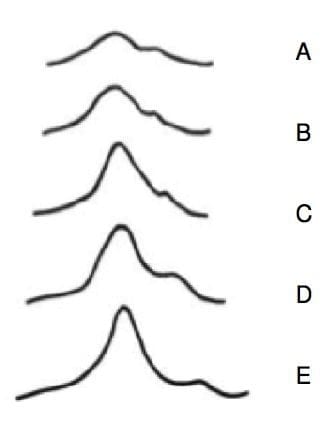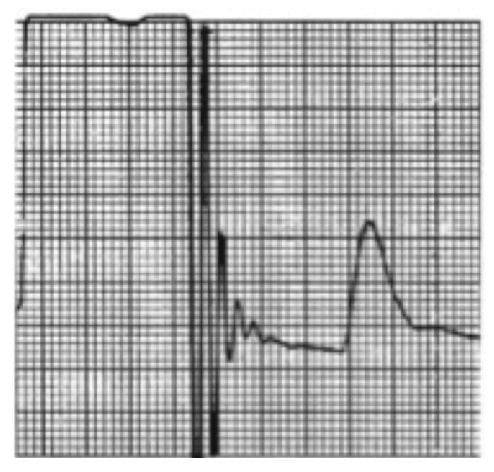CICM SAQ 2010.1 Q11
The following set of questions relate to invasive arterial blood pressure monitoring.
11.1 The above series of figures represents waveforms obtained simultaneously from different arterial sites from the same patient. Assuming optimal dynamic responses, list the likely sites A-E.
11.2. The image below represents a tracing of an arterial waveform.
- (a) What procedure has been performed?
- (b) What is your impression of the fidelity of the arterial system? Give two (2) reasons.
11.3 List the important pieces of information that could be obtained from an arterial waveform tracing.
Answer
Answer and interpretation
11.1. The above series of figures represents waveforms obtained simultaneously from different arterial sites from the same patient. Assuming optimal dynamic responses, list the likely sites A-E.
- A- central aorta
- B- proximal UL
- C- Distal UL or LL
- D- Proximal LL
- E- Distal UL or LL
11.2. The image below represents a tracing of an arterial waveform.
(a) What procedure has been performed?
- Fast flush test
(b) What is your impression of the fidelity of the arterial system? Give two (2) reasons.
- Underdamped trace – Multiple oscillations and systolic overshoot
11.3 List the important pieces of information that could be obtained from an arterial waveform tracing.
- Systolic, diastolic, mean and pulse pressures
- Heart rate and rhythm
- Effect of dysrhythmias on perfusion
- ECG lead disconnect
- Continuous cardiac output using pulse contour analysis
- Specific waveform morphologies might be diagnostic – eg slow rising pulse in AS, pulsus paradoxus in tamponade
- Systolic pressure variation or pulse pressure variation may be useful in predicting fluid responsiveness.

Examination Library
CICM
Chris is an Intensivist and ECMO specialist at The Alfred ICU, where he is Deputy Director (Education). He is a Clinical Adjunct Associate Professor at Monash University, the Lead for the Clinician Educator Incubator programme, and a CICM First Part Examiner.
He is an internationally recognised Clinician Educator with a passion for helping clinicians learn and for improving the clinical performance of individuals and collectives. He was one of the founders of the FOAM movement (Free Open-Access Medical education) has been recognised for his contributions to education with awards from ANZICS, ANZAHPE, and ACEM.
His one great achievement is being the father of three amazing children.
On Bluesky, he is @precordialthump.bsky.social and on the site that Elon has screwed up, he is @precordialthump.
| INTENSIVE | RAGE | Resuscitology | SMACC


